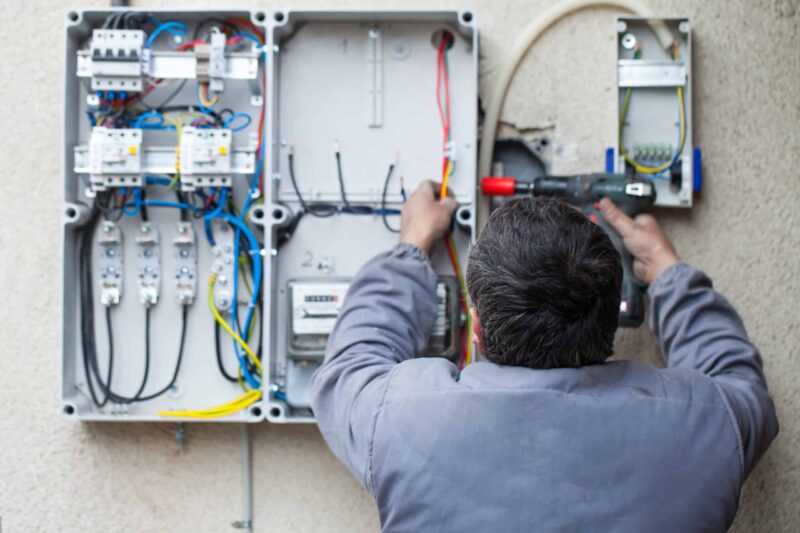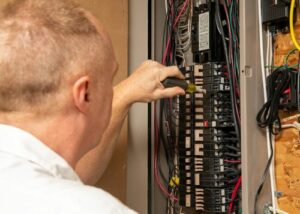Common Electric Problems Every Home Owner Ought To Know Concerning
Homeowners usually come across various electrical troubles that can impact safety and security and performance. Concerns like flickering lights and tripped breaker are much more common than numerous understand. These circumstances can show deeper electric issues that warrant focus. Comprehending the dangers and indications associated with outdated circuitry and dead outlets is essential. What steps can be taken to stop these problems? Checking out these common electric issues might disclose important understandings for preserving a safe home setting.

Flickering Lights: Reasons and Solutions
Why do some home owners experience flickering lights? Flickering lights can be a typical aggravation, frequently suggesting underlying electric issues. One main reason is damaged or loose links within light components or circuitry, which can result in periodic power supply. Furthermore, utilizing high-wattage home appliances on the same circuit may trigger voltage variations, resulting in lowering or flickering. An additional potential problem is an overloaded circuit, where way too many tools attract power at the same time, straining the electrical system. In addition, outdated or degraded electrical wiring can contribute to inconsistent electrical flow. In many cases, flickering lights might signal a problem with the home's electric panel or service line. Property owners ought to resolve flickering lights promptly to prevent prospective threats. Solutions may include tightening up links, rearranging home appliance lots, or speaking with a certified electrician for an extensive evaluation. Determining the root cause can assist guarantee a safe and stable electric system in the home.
Tripped Circuit Breakers: What You Required to Know
Have house owners ever before questioned what causes their breaker to journey suddenly? This common problem frequently develops from an overload of electrical circuits, where a lot of tools attract power simultaneously. In such instances, the circuit breaker works as a security device, interrupting the circulation of power to avoid getting too hot and possible risks. Another constant cause is a brief circuit, which happens when a live wire get in touches with a neutral wire, producing a surge of electrical energy that trips the breaker. Ground mistakes can also cause stumbled breakers; these occur when a live cable touches the ground or a based surface area, posturing severe safety risks. Property owners must frequently analyze their usage of high-wattage home appliances to prevent overwhelming circuits. Furthermore, recognizing the function of circuit breakers can help them react appropriately during a trip, ensuring their home continues to be properly maintained and risk-free.
Obsolete Circuitry: Dangers and indicators
Out-of-date wiring can position significant threats to homeowners, commonly going undetected till troubles arise. Homes built before the 1980s may still have light weight aluminum circuitry or knob-and-tube systems, which are no more considered secure. Indicators of outdated electrical wiring consist of flickering lights, often tripped circuit breakers, or melting smells near outlets. These indicators may suggest that the electric system is loaded down or deteriorating.Additionally, property owners might notice scorch marks around buttons or outlets, which can suggest getting too hot. The threat of electric fires markedly increases with out-of-date electrical wiring, as these systems were not created to manage contemporary electric lots. House owners are motivated to have their wiring evaluated routinely, specifically when restoring or including new devices. By identifying these signs early, they can stay clear of harmful circumstances and maintain a more secure living atmosphere. Upgrading to existing electrical requirements is an aggressive step in preserving home safety and performance.
Frequently Blown Fuses: Troubleshooting Tips
Regular blown fuses can show underlying electric problems that may originate from out-of-date circuitry or overloaded circuits. Homeowners experiencing this trouble ought to initially determine the home appliances connected to the affected circuit. It is suggested to prevent using numerous high-wattage devices all at once, as this can cause circuit overload. If the problem persists, inspecting the circuit box for signs of wear or damage is essential; a faulty circuit box may need replacement.Additionally, looking for loosened connections within the circuit can aid avoid future events. House owners ought to additionally validate that the fuses being used are of the proper amperage, as utilizing an incorrect fuse can intensify the issue. If these troubleshooting ideas do not resolve the issue, getting in touch with a certified electrician is advised to examine the electrical system further. Resolving these concerns without delay can assist minimize threats and assure the safety of the home's electrical infrastructure.
Dead Outlets: Typical Causes and Repairs
When a house owner runs into a dead electrical outlet, it can often provide irritation and complication. Numerous common causes might cause this problem. One regular perpetrator is a tripped breaker, which can be conveniently reset. Home owners must check their electric panel to check if any breakers remain in the off placement. Another opportunity is a damaged electrical outlet itself, which might need replacement. In addition, loose electrical wiring connections within the electrical outlet can interrupt power circulation, making examination essential.Sometimes, the trouble may stem from an overloaded circuit, specifically when numerous devices are connected. In such instances, redistributing the electric tons can fix the problem. House owners should likewise think about the age of their wiring; older systems may require updates to fulfill contemporary electric demands. If these actions do not remedy the situation, getting in touch with a certified electrical expert is suggested to ensure safety and security and proper medical diagnosis.
Electric Shocks: When to Be Concerned
Just how can homeowners figure out whether an electrical shock warrants problem? Homeowners must initially assess the intensity and context of the shock. A moderate fixed shock, commonly really felt when touching steel objects, is common and commonly harmless. If the my website shock occurs while interacting with a plugged-in device or outlet, it may indicate a more severe issue.The area and regularity of the shocks are essential. Repeated shocks from the exact same resource, particularly in wet areas like restrooms or kitchen areas, might signify defective electrical wiring or insufficient grounding. Property owners ought to likewise take into consideration the experience of the shock; a shock that causes pain or contraction is much more alarming than a simple tingle.If there's any type of unpredictability, it is a good idea to get in touch with a qualified electrician. Neglecting prospective electrical dangers can bring about significant security dangers, consisting of fire or severe injury.
Overloaded Circuits: Prevention and Precaution
Overloaded circuits present substantial threats in domestic setups, commonly causing electric fires or devices damage (Level 2 Electrician). Property owners must recognize the indicators of an overloaded circuit, such as often stumbled breakers or dimming lights. Implementing preventive security practices can aid alleviate these hazards and assure a much safer living setting
Acknowledging Overloaded Circuits
What indications indicate that a circuit may be strained? House owners should be cautious for a number of crucial signs. Often tripped circuit breakers or blown merges suggest excessive tons on the circuit. Lowering or flickering lights, especially when various other devices are in use, can signify an inadequate power supply. Additionally, outlets or buttons that really feel warm to the touch may indicate getting too hot, a possible fire risk. Uncommon buzzing audios from outlets also call for attention, as they can signify electric issues. Finally, if appliances operate inefficiently or fall short to begin, it might be an indication of an overloaded circuit. Identifying these indicators early can help stop severe electric troubles and promote a more secure home setting.
Preventive Safety Practices
To maintain a safe and efficient electrical system, house owners must implement precautionary security methods that resolve prospective circuit overloads. One efficient step is to avoid attaching too several gadgets to a solitary electrical outlet, as this can surpass the circuit's capability. Using power strips with integrated circuit breakers can aid disperse power safely. House owners need to likewise consistently check cables and devices for damages and replace any damaged tools immediately. It is vital to ensure that breaker are functioning appropriately and to be knowledgeable about the complete electrical power being made use of in each circuit. Additionally, seeking advice from an accredited electrical contractor for periodic inspections can determine possible issues before they escalate, ensuring a much safer living environment and extending the lifespan of electric systems.
Regularly Asked Concerns
Exactly how Usually Should I Have My Electrical System Inspected?
Normal inspections of electric systems are advised every 3 to five years. House owners ought to consider much more constant checks if they experience issues, undertake restorations, or live in older residential or commercial properties to ensure safety and security and compliance.
Can I Deal With Electrical Issues Myself or Hire a Specialist?

What Are the Indicators of an Electric Fire Threat?
Indicators of an electrical fire danger consist of regularly stumbled breaker, flickering lights, burning smells, stained electrical outlets, or warm, buzzing cords. House owners must continue to be alert and seek specialist support if any one of these signs are existing.
Exactly how Do I Know if My Home Demands an Electrical Upgrade?
To figure out if a home needs an electrical upgrade, indicators consist of constant breaker journeys, out-of-date electrical wiring, inadequate electrical outlets, flickering lights, and the existence of older electrical panels, indicating potential safety dangers and inefficiency.
Are There Details Safety Tips for DIY Electrical Work?
When considering DIY electrical job, one need to this hyperlink constantly turn off power, utilize protected tools, verify circuit performance, comply with neighborhood codes, and consult specialists for complicated tasks to ensure security and prevent crashes. One more potential concern is an overloaded circuit, where as well many devices draw power at the same time, stressing the electrical system. The threat of electrical fires considerably boosts with obsolete wiring, as these systems were not developed to handle modern-day electrical tons. Constant blown merges can show underlying electric concerns that may stem from click here for more info obsolete electrical wiring or overloaded circuits. To maintain a reliable and safe electric system, property owners must apply preventive safety and security techniques that attend to prospective circuit overloads. Level 2 Electrician Sydney. Indicators of an electrical fire danger consist of frequently stumbled circuit breakers, flickering lights, melting odors, discolored electrical outlets, or cozy, buzzing cords